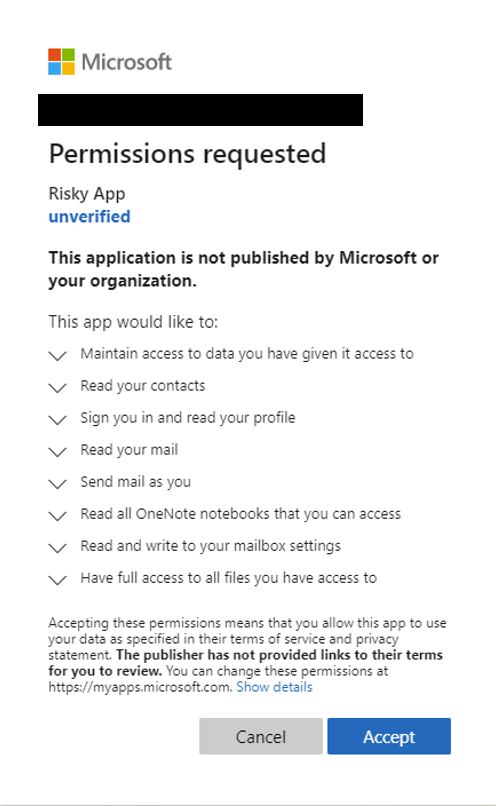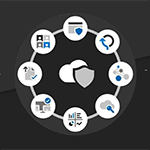Protecting your remote workforce from application-based attacks like consent phishing
The global pandemic has dramatically shifted how people work. As a result, organizations around the world have scaled up cloud services to support collaboration and productivity from home. We’re also seeing more apps leverage Microsoft’s identity platform to ensure seamless access and integrated security as cloud app usage explodes, particularly in collaboration apps such as Zoom, Webex Teams, Box and Microsoft Teams. With increased cloud app usage and the shift to working from home, security and how employees access company resources are even more top of mind for companies.
While application use has accelerated and enabled employees to be productive remotely, attackers are looking at leveraging application-based attacks to gain unwarranted access to valuable data in cloud services. While you may be familiar with attacks focused on users, such as email phishing or credential compromise, application-based attacks, such as consent phishing, is another threat vector you must be aware of. Today we wanted to share one of the ways application-based attacks can target the valuable data your organization cares about, and what you can do today to stay safe.
Consent phishing: An application-based threat to keep an eye on
Today developers are building apps by integrating user and organizational data from cloud platforms to enhance and personalize their experiences. These cloud platforms are rich in data but in turn have attracted malicious actors seeking to gain unwarranted access to this data. One such attack is consent phishing, where attackers trick users into granting a malicious app access to sensitive data or other resources. Instead of trying to steal the user’s password, an attacker is seeking permission for an attacker-controlled app to access valuable data.
While each attack tends to vary, the core steps usually look something like this:
- An attacker registers an app with an OAuth 2.0 provider, such as Azure Active Directory.
- The app is configured in a way that makes it seem trustworthy, like using the name of a popular product used in the same ecosystem.
- The attacker gets a link in front of users, which may be done through conventional email-based phishing, by compromising a non-malicious website, or other techniques.
- The user clicks the link and is shown an authentic consent prompt asking them to grant the malicious app permissions to data.
- If a user clicks accept, they will grant the app permissions to access sensitive data.
- The app gets an authorization code which it redeems for an access token, and potentially a refresh token.
- The access token is used to make API calls on behalf of the user.
If the user accepts, the attacker can gain access to their mail, forwarding rules, files, contacts, notes, profile and other sensitive data and resources.

Consent screen from a sample malicious app named “Risky App”
How to protect your organization
At Microsoft, our integrated security solutions from identity and access management, device management, threat protection and cloud security enable us to evaluate and monitor trillions of signals to help identify malicious apps. From our signals, we’ve been able to identify and take measures to remediate malicious apps by disabling them and preventing users from accessing them. In some instances, we’ve also taken legal action to further protect our customers.
We’re also continuing to invest in ways to ensure our application ecosystem is secure by enabling customers to set policies on the types of apps users can consent to as well as highlighting apps that come from trusted publishers. While attackers will always persist, there are steps you can take to further protect your organization. Some best practices to follow include:
- Educate your organization on consent phishing tactics:
- Check for poor spelling and grammar. If an email message or the application’s consent screen has spelling and grammatical errors, it’s likely to be a suspicious application.
- Keep a watchful eye on app names and domain URLs. Attackers like to spoof app names that make it appear to come from legitimate applications or companies but drive you to consent to a malicious app. Make sure you recognize the app name and domain URL before consenting to an application.
- Promote and allow access to apps you trust:
- Promote the use of applications that have been publisher verified. Publisher verification helps admins and end-users understand the authenticity of application developers. Over 660 applications by 390 publishers have been verified thus far.
- Configure application consent policies by allowing users to only consent to specific applications you trust, such as application developed by your organization or from verified publishers.
- Educate your organization on how our permissions and consent framework works:
The increased use of cloud applications has demonstrated the need to improve application security. At Microsoft, we’re committed to building capabilities that proactively protect you from malicious apps while giving you the tools to set policies that balance security and productivity. For additional best practices and safeguards review the Detect and Remediate Illicit Consent Grants in Office 365 and Five steps to securing your identity infrastructure.
Bookmark the Security blog to keep up with our expert coverage on security matters. Also, follow us at @MSFTSecurity for the latest news and updates on cybersecurity.
READ MORE HERE



